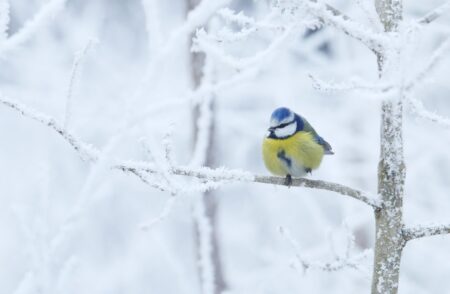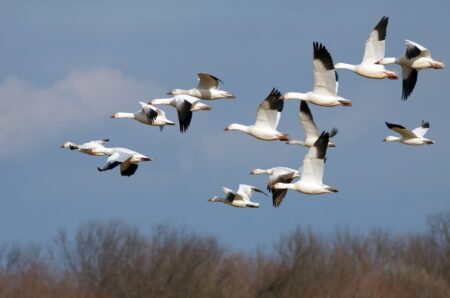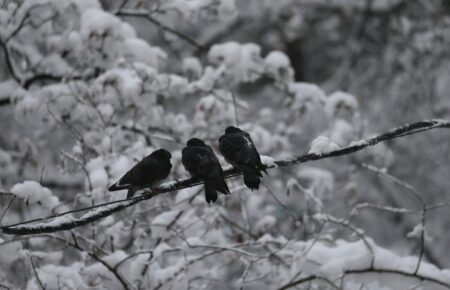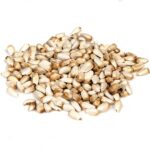How Do Birds Survive Winter?
Winter can be a tough time for birds, with cold temperatures, limited resources, and harsh conditions. Yet, it’s also a time of survival, adaptation, and resilience for these incredible creatures. Despite the many challenges, birds have evolved various strategies and behaviors to help them get through the winter months. In this article, we will discuss several ways birds survive the winter.
How Do Birds Survive Winter?
Birds have various adaptations and behaviors that help them survive the harsh winter conditions:
- Migrating: Many birds that live in colder regions during the summer migrate to warmer areas during the winter. This is an effective way for them to avoid harsh weather and search for food in more favorable conditions.
- Insulating feathers: Birds have a layer of feathers that acts as insulation, trapping warm air and keeping their bodies warm. Some birds also fluff up their feathers to create an even thicker layer of insulation.
- Shivering: Birds will shiver to generate body heat when the temperature drops. This is similar to how mammals like humans shiver to stay warm.
- Roosting: Birds will find sheltered areas like dense vegetation, tree cavities, or nest boxes to roost in during the night. This helps them conserve body heat and stay out of the wind and cold.
- Huddling: Some birds, such as penguins, huddle together in large groups to conserve body heat. They take turns rotating to the center and the outer edge of the huddle to give each other a chance to warm up.
- Growing extra feathers: Some birds, such as northern cardinals, develop extra feathers in the fall to provide more insulation during the winter months.
- Lowering their metabolic rate: During winter, birds may lower their metabolic rate, which reduces their energy needs and helps them conserve energy.
- Finding alternative food sources: In winter, food may be scarce, so birds may look for alternative food sources such as seeds, berries, insects, and even garbage.
- Shifting their diet: Certain bird species, like chickadees and woodpeckers, change their diet during the winter to include more high-fat and high-protein foods, which provide them with the energy they need to stay warm.
- Drinking from unfrozen water sources: Some birds will use their beaks to break through ice to reach unfrozen water sources. Others will try to find unfrozen water or even eat snow to stay hydrated.
How Birds Adapt To Winter Weather
- Migration: Many birds, such as geese, swans, and songbirds, have the ability to migrate to warmer climates during the winter months. They use their strong flying abilities to travel south, where food and shelter are easier to find.
- Insulation: Birds have specialized feathers that help them stay warm in cold weather. Their feathers are layered and have small, fluffy pieces called down feathers that trap warm air close to their bodies.
- Shivering: Like humans, birds also have the ability to shiver, which helps generate body heat to keep them warm in colder temperatures.
- Puffing Up: Birds have a unique ability to puff up their feathers, which creates a layer of air between their feathers and their body. This trapped air acts as insulation and helps them stay warm.
- Changing Diets: In colder weather, food sources for birds can become scarce. To adapt, birds may change their diets, shifting from insects and seeds to berries and fruits, which are more abundant during the winter months.
- Roosting: Some birds, such as chickadees, will seek out sheltered areas like thick bushes or tree cavities to roost at night. This provides protection from the wind and helps them conserve body heat.
- Huddling Together: Many birds, such as penguins and snow geese, will huddle together in large groups to conserve body heat during the night. This also helps protect them from harsh winds and snow.
- Torpor: Some small birds, like hummingbirds and kinglets, enter a state of torpor during the night, where their body temperature and metabolic rate decrease to conserve energy and keep them warm.
- Fattening Up: Before winter arrives, birds will often increase their food intake to build up fat reserves, providing them with a source of energy to help them survive through the colder months.
- Adapting Songs: Some birds change their songs during the winter months to conserve energy. Instead of complex songs, they may use simple chirps and calls to communicate with other birds.
SEE ALSO: What Birds Eat Safflower Seeds?
What Do Birds Eat in The Winter?
Birds eat a variety of food in the winter to sustain themselves and survive the cold weather. Here are some common foods that birds eat during the winter:
- Seeds: Seeds are a staple food for many bird species during the winter. Different types of seeds are available throughout the winter months, including sunflower, millet, and thistle seeds. Birds can easily find these seeds in bird feeders, on the ground, and in plants.
- Berries: Some birds, such as robins, cedar waxwings, and bluebirds, rely on berries as a food source during the winter. These fruits may be leftover from the fall or wintering berries found on evergreen trees and shrubs.
- Insects: While most insects are dormant during the winter, some birds, such as woodpeckers, chickadees, and nuthatches, are able to find and eat larvae, eggs, and other small insects hidden under tree bark.
- Nuts: Nuts, such as acorns and hickory nuts, are another important food source for birds in the winter. These nuts provide a high-fat content that helps birds maintain their energy and stay warm.
- Suet: Suet is a popular food for birds, especially during the winter months. Suet is made from animal fat and provides a high-calorie, high-fat food source that helps birds survive the cold weather.
- Fruits and Vegetables: Certain fruits and vegetables, such as apples, pears, and seed heads from plants like coneflowers and black-eyed Susans, can also be a food source for birds in the winter.
- Homemade Treats: Some bird lovers like to create homemade treats for their feathered friends, such as peanut butter and seed cakes, which can provide essential nutrients and energy to help birds survive the winter.
- Water: While birds may not need as much water during the winter as they do in warmer months, they still require access to clean, unfrozen water. Providing a heated birdbath or regularly changing out the water in a non-heated birdbath can help birds stay hydrated during the winter.
Where Do Small Birds Go in The Winter?
Small birds typically migrate to warmer climates during the winter months to avoid harsh weather conditions and to find better food sources. Some small birds may also hibernate, enter a state of torpor, or seek shelter in snug spaces to conserve heat. The specific behaviors and strategies that small birds use to survive the winter can vary depending on their species, habitat, and available resources.
How Do Birds Stay Warm at Night?
- Insulation: Birds have feathers that provide insulation to help them retain body heat. Birds have two types of feathers- contour feathers which cover the body and down feathers which are soft and fluffy and provide additional insulation.
- Roosting: Birds choose roosting spots that provide shelter from the cold and wind. This can be in trees, bushes, dense vegetation, or even in holes in the ground or in buildings. Roosting with other birds also helps to keep them warm by huddling together.
- Puffy feathers: Birds fluff up their feathers to create a layer of trapped air between the feathers. This trapped air acts as insulation and helps to keep the bird warm.
- Tucking in legs: Some birds, like ducks and geese, have the ability to tuck their feet into their feathers while roosting. This helps to reduce heat loss as the feet are often the first part of the body to get cold.
- High metabolism: Birds have a high metabolic rate which helps them to generate and maintain body heat. They also have a specialized respiratory system that allows them to extract more oxygen from the air, which helps to fuel their high metabolic rate.
- Shivering: Similar to mammals, birds also shiver to generate body heat. The rapid muscle contractions produced during shivering create heat and help the bird to stay warm.
- Sunbathing: Some birds, like the American robin, have been observed sunbathing on cold winter days. This helps them to absorb warmth from the sun, which can be stored in their feathers for later.
How to Help Birds in Winter
Winter is a tough time for birds and, as a bird lover, you may want to do everything you can to help them survive the colder months. Here are a few simple ways to help birds in winter:
- Provide Shelter: As winter brings harsh winds and snow, birds need a safe place to take shelter. You can help by providing a birdhouse or nesting box in a sheltered area. Make sure the entrance is facing away from the direction of the prevailing winds.
- Offer Food: As food becomes scarce in winter, birds will appreciate a helping hand. You can put up a bird feeder and fill it with high-energy foods like suet, sunflower seeds, and peanuts. These foods will provide the necessary nutrients for birds to stay warm and maintain their energy levels during the colder months.
- Keep Water Available: During winter, natural sources of water for birds may be frozen over, making it difficult for them to find water. By providing a birdbath with fresh water, you can help birds stay hydrated. Make sure to keep the birdbath clean and replace the water daily to prevent it from freezing over.
- Plant Native Vegetation: Consider planting native shrubs and trees in your yard to provide birds with a natural source of food during winter. Native plants can also provide shelter and nesting spots for birds.
- Avoid Using Pesticides: Pesticides can be harmful to birds, especially during winter when food sources are scarce. Instead, try using natural methods to control pests in your garden.
- Don’t Disturb Nesting Birds: Avoid pruning trees and shrubs during winter as birds may be using them for shelter. If you do need to prune, check for nests beforehand and try to prune at a time when birds are less likely to be nesting.
- Be Aware of Predators: During winter, predators may also be struggling to find food and may prey on birds. Keep an eye out for potential predators in your area and try to deter them as much as possible.
FAQs
Q. Can birds freeze to death?
A. Yes, birds can freeze to death in extremely cold temperatures.
Q. Do birds feel cold on their feet?
A. Yes, birds can feel cold on their feet as they are exposed to the environment and do not have fur or thick skin to protect them from low temperatures.
Q. What temperature is too cold for birds?
A. The exact temperature that is considered too cold for birds may vary depending on the bird’s species, age, and health. However, a general rule of thumb is that most birds can handle temperatures between 50-80 degrees Fahrenheit.
Q. What temperature can birds survive in summer?
A. Most birds can survive in summer temperatures ranging from 60-100 degrees Fahrenheit. However, some species, such as penguins, require cooler temperatures and may struggle in temperatures above 80 degrees Fahrenheit.
SEE ALSO: What Do Bluebirds Eat?
Conclusion
Birds have various adaptations that allow them to survive the harsh conditions of winter. From physical changes, such as growing thicker feathers and shivering, to behavioral changes, such as migrating to warmer areas and storing food, birds have evolved different strategies to cope with cold temperatures, low food availability, and limited resources during the winter season. Additionally, their ability to regulate their body temperature and conserve energy also plays a critical role in their survival during this challenging time. Furthermore, the presence of humans who provide food and shelter for birds during the winter months also contributes to their ability to survive. Overall, birds have developed remarkable adaptations and behaviors that have allowed them to thrive even in the harshest winter conditions.


